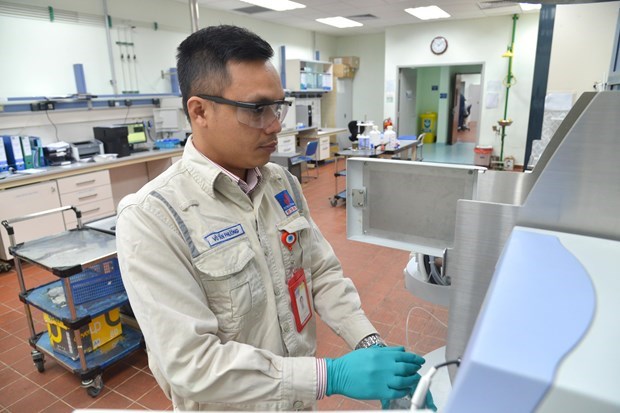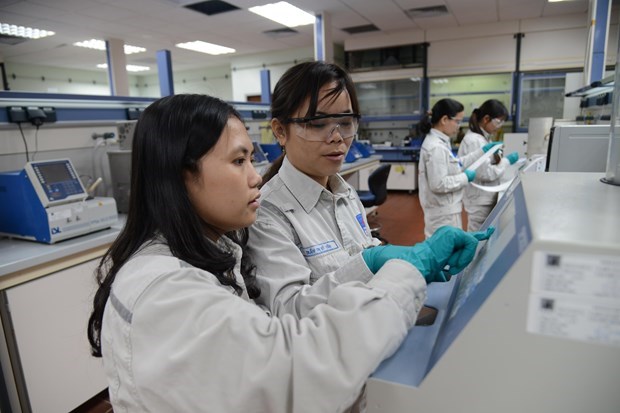New technical solution brings breakthrough to Dung Quat Refinery
 Engineer Vo Tan Phuong conducts experiments with modern equipment at BRS lab (Photo: VietnamPlus)
Engineer Vo Tan Phuong conducts experiments with modern equipment at BRS lab (Photo: VietnamPlus)
Hanoi (VNA) – The success application of a solution to analysearsenic content in samples at Dung Quat Refinery to actively prevent and control the effects of arsenic at the workshop has savedabout 1 billion VND per year for the business.
After a time of researching, from March2018, the Quality Management Board of the Binh Son Refining and Petrochemical Co., Ltd (BSR), the operator of Dung Quat Refinery, has successfully applied a “solution to analyse arsenic content in samples taken from Dung Quat Refinery to actively prevent and control the impacts of arsenic in technology workshops” into the plant’s production.
Engineer Vo Tan Phuong, co-author of the project, said that the solution has made the plant more active in controlling arsenic content in samples from crude oil and intermediary products to final propylene product, thus contributing to ensuring the quality of propylene products provided for the Polypropylene Factory to produce high quality Polypropylene plastics.
Controlling arsenic content leads to over 1 billion VND in profit each year
In Dung Quat Refinery, on the foundation of the system handed over by the contractor of Technip, the analysis and control of arsenic content, which have been implemented on three samples of crude oil, intermediary product of Naphtha and LPG/Propylene products to manage the operational indicators and define the quality of the products, are necessary. However, a number of current analysis methodshave yet to be able to control the arsenic content, especially with small ratio.
Previously, there was no plan to control the arsenic content in crude oil and oil residue provided for the Residue Fluid Catalytic Cracking (RFCC).
For LPG/Propylene products, the firm has planned to manage the arsine content through the ASTM D4599 method using dragger tube and colour comparison with the detection range from 0.05ppm (or 50ppb). However, the maximum safe arsenic content for Propylene products is only 0.03ppm (or 30ppb).
Therefore, the ASTM D4599 method was not suitable for the analysis of arsenic in low content. For the Naphtha product, the firm used UOP 946.
After recognizing the problems, the researching team proposed the solution to analyse arsenic content in samples taken from Dung Quat Refinery to actively prevent and control the impacts of arsenic in technology workshops” into the plant’s production.
According to Phuong, the objective of the solution is to build a method of analyzing the arsenic content in LPG/Propylene product with the ratio of under 5ppb to meet the technical and quality regulations. At the same time, it also studies the process of treating samples of crude oil and oil residue, optimizing the indicators of AAS analyzing equipment to increase its sensitiveness in analyzing arsenic content in the samples.
“Before applying the method, the BSR had to send the samples to a research unit outside for analysis, which was costly. The successful application of this solution has helped save about 1 billion VND per year,” said Phuong.
 BSR engineers have had many initiatives, bringing in billions of VND to the company (Photo: VietnamPlus)
BSR engineers have had many initiatives, bringing in billions of VND to the company (Photo: VietnamPlus)Human plays key role, equipment serves as foundation
Engineer Tran KhanhLinh, who works with Phuong in the research, said that in order to ensure the success of the project, they considered manpower as a key factor and equipment as the foundation for the success.
“We used principles of the AAS-Graphite Furnace machine to build programmes of to analyse the samples with the major samples being the arsenic-contaminated LPG/Propylene and petroleum products with organic and inorganic arsenic,” she said.
Along with the success in researching the method of treating the samples, the solution also helps optimize the technical indicators in the AAS equipment for higher sensitiveness of the equipment, contributing to improving the arsenic limitation range to 5ppb, according to Linh.
Pham Cong Nguyen, head of the BRS’s Quality Management Board, said that with the success, the solution has been applied into reality to control the arsenic content of all samples taken from Dung Quat Refinery such as crude oil, oil residue, Naphtha, and LPG/Propylene, helping the company become self-reliant in the work and save cost, thus increasing the firm’s profit.
“The successful application of the solution has affirmed the quality of personnel of the board who have mastered the equipment system in the lab,” stressed Nguyen./.













